Imagine, if you can, a truck with factory-mounted seats in the bed – and spotlights the size of a 747’s landing lights mounted on its T-topped roof.
If you know this truck, you also know why it’s no longer available. Such fun things are no longer allowed. They are not saaaaaaaaaaaaaaaaafe! “Moms” are “concerned”! But in 1977, the Safety Cult – which ended such fun things – was still a backwater aberration, like dancing with rattlesnakes – and most people still esteemed fun over fear. There were roofless Broncos and K5 Blazers – and cars with beds.
You could buy all kinds of different stuff back when America was still a fairly free country – and the Subaru BRAT was as different as it got.
BRAT – all caps – was short for Bi-Drive Recreational All-Terrain Transporter. It was superficially similar to other small import pickups of the ’70s, such as the Datsun 620 and similar models from Toyota (SR5), Mazda (B210) and Chevy (via Isuzu) Luv.
But unlike them, it was a four seater – with two of the four in the bed, facing the other way. The seats were made of all-weather plastic and far from the most comfortable – but the view was spectacular. Watching the world recede as your progressed is another one of many freedoms denied today, in the name of “safety.”
Subaru wasn’t “unconcerned” about “safety.” Grab handles – to keep passengers from bouncing out of the bed – were included. Though holding onto them made it harder to reach for a cold one in the cooler. That was another fun thing people did in pick-ups back in the day – before the Safety Cult put the kibosh on that, too.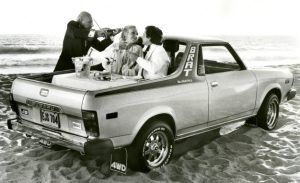
The seats were actually a dodge – of a federal fatwa known as the “chicken tax,” which was a retaliatory tariff of 25 percent applied to import-brand pickups manufactured outside the United States as tit-for-tat for tariffs applied by foreign countries to American chicken exported outside the United States.
The “chicken tax” hit trucks with just two seats, which at the time was almost exclusively the small import models, which didn’t offer the extended and crew cab configurations that are commonplace today.
By adding the extra seats in the bed, BRAT qualified as a passenger vehicle rather than a “light truck” and thus Subaru evaded the chicken tax on a happy technicality – and was also able to sell the BRAT for less than two-seater rivals that had the cost of the tax folded into their MSRP.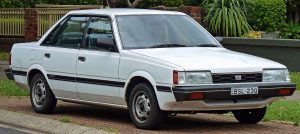
Which was $4,199 back in ’77 – not including the optional removable T-tops. But the price did include a spare tire mounted under the hood and a spring-loaded door that concealed a built in foot step to facilitate getting into the bed.
The extra pair of seats did more than just help Subaru dodge an obnoxious tax. They made the BRAT much more practical as a people hauler that could also haul stuff. The extra seats – in the back – also endowed it with a snarky attitude that the more utilitarian compact pickups of the day couldn’t match.
The BRAT was also stylish – a striking contrast to other import trucks of the era, which weren’t. It borrowed themes from cars with beds, like the Chevy El Camino and Ford Ranchero – which had backward swooping C pillars and a car-like rake to their windshields.
They were however, still cars – and with only two seats, too.
And while they had beds and so could carry mulch or sheetrock like a truck – or even people, if they didn’t mind not having seats – the El Camino and Ranchero rode as low to the ground as the cars they were based on – and did not offer four-wheel-drive.
The BRAT came standard with it.
Well, sort of – depending on your definition of 4WD.
Historically, “4WD” meant a vehicle – usually a truck – equipped with a system that let the driver engage the front wheels when the rear wheels began to slip. Most of the time, the rear wheels propelled the vehicle.
In the BRAT, it was the reverse.
It was based on a front-wheel-drive car, the Leone (Lion) which at the time was Subaru’s largest, fanciest car. It was also the car Subaru used to pioneer powering all four wheels in something that wasn’t a truck – a common thing in today’s cars but a very uncommon thing in the early 1970s, when cars were two-wheel-drive (either the front wheels or the rear wheels – but almost never all four of them).
Subaru was among the first to apply the principle to a car – and then to a truck, at least kinda-sorta. The BRAT was basically a Leone with a different body – in the same way that a modern Outback is basically a jacked-up Legacy. And in the same way a modern Honda Ridgeline is actually a Honda Pilot . . . with a bed.
It’s a common practice because it allows a car company to make more than just one vehicle using a single “platform,” or underlying chassis.
Semantics aside, all four of the BRAT’s wheels were powered. Or could be powered. Just like a 4WD truck, the Soobie’s 4WD could be disengaged when extra traction wasn’t needed – and to save both wear and tear on the components as well as gas, since it took less horsepower to power two rather than four wheels.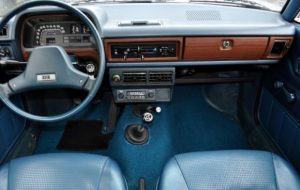
But there wasn’t much power to toggle.
The early BRATs came standard with a 1.6 liter iteration of Subaru’s “boxer” (horizontally opposed) four cylinder engine that made 67 horsepower, at your command via the standard four speed manual or three speed automatic transmission.
But then, it was 1977 – and the the quickest car on the road that year was a 6.6 liter Trans Am packing 200 hp, which on a power-per-liter basis wasn’t all that much more powerful than the Soobie’s 1.6 liter engine.
The TA was quicker – but not by much. And it didn’t get 34 MPGs on the highway, which the Subaru did. The TA also didn’t have almost 9 inches of ground clearance, as the BRAT had and – Smokey & The Bandit notwithstanding – couldn’t ford streams much less jump bridges.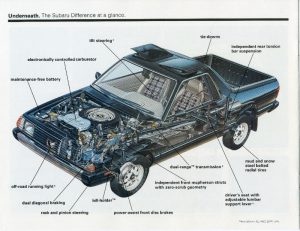
The BRAT couldn’t jump bridges either, of course – at least, not without the assistance of Hal Needham (the stunt coordinator for Smokey & The Bandit, who totaled several brand-new Trans-Ams making those jumps) but fording streams was no problem and not getting stuck was what this thing was all about. Especially later GL models, which featured Low range gearing, very much like a truck.
The BRAT helped establish Subaru as the go-anywhere brand . . . just not very quickly.
It did get a little quicker in 1981, when Subaru upped the underhood ante to 1.8 liters – which almost crossed the 100 hp threshold. A five-speed overdrive manual transmission eventually replaced the four speed without overdrive, too. Later on, in ’83, a turbocharged and fuel-injected version of this engine was offered that did cross it – but this version of the BRAT was only offered with an automatic transmission and the single-speed 4WD/AWD system, still driver-selectable.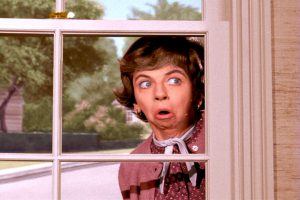
The BRAT was a popular model for Subaru but its days were numbered as the Safety Cult metastasized into a national religion. “Baby on Board” placards began to appear in the back windows of cars driven by “concerned” moms around this time and it would not be long before their “concern” extended to what adults did in the back of pickups. Or rather, what adults were allowed to do in the back of pickups.
Riding in the bed became illegal – and this effectively illegalized the BRAT or at least, took away its signature selling point. Without the jump seats – and experience of riding facing backward – the BRAT was just another small pick-up, like the rest.
It was dropped after the 1987 model year.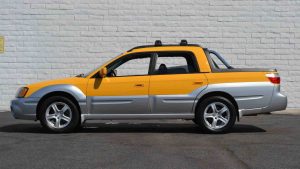
Subaru made an effort to revive the spirit of the BRAT in 2002 when it launched a BRAT-like vehicle called the Baja (no all caps because the name wasn’t an acronym). Instead of four seats – two in the bed – it had four doors, with the back seats inside and facing forward.
Just like every other car.
Which probably explains why the Baja only existed for three years before it got dropped. Though not a bad vehicle (it shared its platform with the same era Outback wagon) it was a nothing-special vehicle. By 2002, AWD – or 4WD, whichever you prefer – was a commonplace feature available in many new cars and many of these – including the Outback – also offered generous ground clearance and the ability to ford streams and unplowed roads.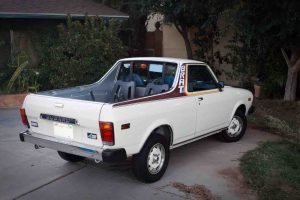
The Baja did have a bed, but without those seats it was missing something. That certain something that makes the difference between a meal you remember and savor – and just dinner.
The BRAT was something special – and we shall not see its like again. At least, not until the leaders of Safety Cult are forced to drink their own Kool Aid. Or just leave the rest of us alone.
Subaru BRAT Trivia:
-
- The original 1977 BRAT came standard with radial tires, tinted glass and a pushbutton radio. It was, after, all, 1977.
- Available colors included Crystal Blue, Plaza White, Mild Yellow, Brilliant Red and Sprite green. BRAT was spelled out on the C pillars in vertically stacked block letter decals.
- In addition to being one of the first vehicles of its type – a car-based utility vehicle with standard 4WD/AWD – the BRAT was also one of the first vehicles to come with more than a 12-month 12,000 standard warranty. Subaru included an 18 month/18,000 mile warranty with every BRAT sold.
- Ronal Reagan was a BRAT owner. His 1978 model (restored since his death) is now a static display at his California ranch.
- One of the reasons for the BRAT’s exceptional gas mileage – 34 highway would be a good number today – was due to its exceptionally low curb weight, just over 2,000 lbs. To get a handle on just how light that is, consider the weight of its attempted successor, the Baja. Though roughly the same overall size, the Baja’s curb weight was a beefy 3,485 lbs or nearly twice the weight of the original ’77 BRAT. Which explains why the Baja only managed 26 MPG on the highway – which is only 1 MPG more than the ’77 BRAT delivered in city driving. Thank the “concerned moms” for this, too.
Excerpted from the forthcoming (eventually) book, Doomed.
. . .
Got a question about cars, Libertarian politics – or anything else? Click on the “ask Eric” link and send ’em in!
If you like what you’ve found here please consider supporting EPautos.
We depend on you to keep the wheels turning!
Our donate button is here.
If you prefer not to use PayPal, our mailing address is:
EPautos
721 Hummingbird Lane SE
Copper Hill, VA 24079
PS: Get an EPautos magnet or sticker or coaster in return for a $20 or more one-time donation or a $10 or more monthly recurring donation. (Please be sure to tell us you want a magnet or sticker or coaster – and also, provide an address, so we know where to mail the thing!)
My latest eBook is also available for your favorite price – free! Click here. If that fails, email me at EPeters952@yahoo.com and I will send you a copy directly!











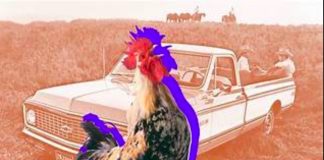
I still prefer my 1983 Dodge Rampage.
Hey Eric,
The photo in the article is the black Subaru brat that I purchased from ebay! Great vehicle, still only has ~72K miles! Gets me lots of looks and conversations. Purchased from a nice old lady in VA. I slightly modified it with a 2″ lift, new paint job and other small goodies, I bounce around the Adirondacks with it and it’s been a blast. Great article!
I owned a 1980 BRAT. The problem with mine was that it was owned by a young idiot, transported many kegs, went places it really shouldn’t have gone, hit a few things it shouldn’t have due to it’s drivers attention being elsewhere at the moment of impact. I managed to get 4 very hard years out of it. I have many fond memories of the BRAT, but I bet it has fewer fond memories of me!
Fort Bragg 1980. One of the guys in my platoon had a BRAT and he seemed to always get the job of transporting our drunks back to the barracks. Jump seats were not used. Just an inebriated GI sprawled out on that tiny bed. Ah, the good old days.
A friend had one. I think the interior was smaller than a Geo Metro as I recall. He took great delight in bouncing me down some dirt roads with the little bomber.
Hi Torino,
I got to drive several as brand-new models, when I was a kid back in the ’80s – because I worked at a Subaru dealer as a detailer/lot boy. They are small, but surprisingly roomy, too. I’m 6 feet 3 and had no problems with head or legroom. I wish I could go back in time and teleport one of them back to the now!
Back in the 80s the older kid across the street had a BRAT. One of the next door neighbors had a suburu wagon. Didn’t take long to figure out they were the same basic vehicle with two different bodies.
My buddy still has one and gets offers on it all the time. He had several old Subarus throughout the years. We used to make a pilgrimage to the “remove it yourself” wrecking yard 80 miles away to strip Subarus for parts and and other cars for whatever anyone else along for the ride wanted…Good Times!…My aunt had one of the early imports of a Subaru sedan. It was the most basic vehicle imaginable. The gas mileage was incredible! It seems we could drive from the center of Texas to Houston and back on one tankful. That was way over any mpg almost any car then or now could have I’m sure.
Hi Tommy,
I’d love to have a BRAT. It’d suit my needs even better than my ’02 Frontier because no computers, EFI or air bags. I ought to start looking…
My next door neighbor had a Brat and I thought it was one of the coolest vehicles I’ve ever seen at the time (probably 6-8 y/o at the time). Sadly he wrecked it and replaced it with an early 80s golden brownish Subaru wagon. His dad also had a very cool International Scout…that was a very cool vehicle as well. And his daughter had a bright yellow Civic CVCC. Very cool family. He never did the lawn..the dad…he had the yard full of rocks….smart man, as doing the lawn took away time from drinking Buds, which he always had in his hand lol
I knew several people who purchased new BRATS and they all removed the rear seats after delivery.
“By adding the extra seats in the bed, BRAT qualified as a passenger vehicle rather than a “light truck” and thus Subaru evaded the chicken tax on a happy technicality – and was also able to sell the BRAT for less than two-seater rivals that had the cost of the tax folded into their MSRP.”
OK, the Chicken Tax. I finally get it. When they were new, I thought the BRAT was Really Stupid, because those seats diminished the cargo carrying utility so much. But if they also diminished the price by 25%, some buyers must have considered that to be an acceptable trade off. Plus the “different/fun/cute” factor appealed to some (but not all) as well.
Some of us wanted maximum cargo capacity, and thought those seats were pretty dorky. In fact, this might have been the beginning of the “dorkiness” that remains a Subaru “feature” to this very day. But as you noted, that was a golden time before vehicles because so homogenous. You paid your money, and bought just the flavor of car or truck you wanted. For that reason only, I too will tip my cup to the BRAT.
PS….Eric, my first job was doing the same thing as you for a used sports car lot on Colorado Blvd in Pasadena. Mostly Austin Healeys, MG-As, and Jags, with the occasional Vette. In fact, an XK-E was the first car in which I ever went well over 100mph. I wasn’t driving: the lot owner was. But the sound of that straight six Jag engine was the Best Ever.
Excellent, Mike!
Those days being out in the sun and young and playing with cars… best times, ever.
Eric,
Thanks for sharing this blast from the past with us! I remember the BRAT; though I never rode in or drove one, I remember them. I always wondered why they disappeared. Should’ve known UNCLE had something to do with it…
I remember the Subaru all-wheel-drive cars from the late 70’s and early 80’s. They were the lowest price Japanese car on the market and went better in snow than any of them, all while getting pretty good mpg. Of course, the Rust Worms liked them too, but no worse than the Datsuns and Toyotas of that era. The biggest thing that would delegate one to the junk yard muey pronto were the antifreeze leaks. They had a 3 piece block as there were two sets of twin cylinder cases that bolted onto the crankcase, after which each cylinder case had head bolted on. All of that expansion and contraction made for a bad combination, and I understand that even the new ones still have the same problem they had 40 years ago.
Hi Dave,
Yup! The BRAT is one of my all-time favorite vehicles; I spent a summer as a teenager working as a detailer/prepper at a Suburu store and got to drive brand-new ones, back in the day. How I wish I could have afforded one, back in the day!
The Subaru pattern was a revese VW.
By being a sidewinder engine and transmission most FWD have more power by not making a 90 degree turn via a set of cross cut gears.